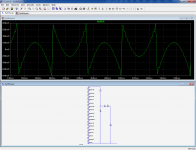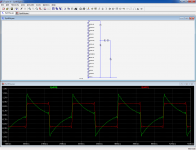The 20 Hz hi pass filter is a good thing to have if you are using something like a Linkwitz open baffle with eq for the cancellation of the OB. Some customers seem to like using it and even if they have a $$$ system doesn't mean it is problem free.
Wayne, I can tell you that with a vinyl source, an 20Hz, 6dB/oct HP is not enough to keep a woofer’s coil in the gap when on a OB, U or W frame even with no eq for dipole cancellation, unless the playback volume is set low.
I might concur that 20Hz 'might' be better than 10Hz, IF you really need a filter.
The battle for preservation of 17.2Hz for organ and 27.3Hz for piano, is an excuse for a numbers game, I am sorry to say this
However, the bass transient response will suffer, even with an added 10Hz filter.
Have you ever heard these notes? (they are rarely played much less recorded).
Pull as many stops as you wish Mr. Curl but there is no transient effect perceived at 10 or 20 Hz or 30Hz with any musical instrument. The effect is perceived only through the higher harmonics (if the instrument produces them) as Esperado wrote
And if we are horrified with what we see on the screen of an instrument (phase shift, group delay, transient response or whatever) we should check on the acoustically perceived effect before drawing any conclusion.
If a 6dB/oct filter has a detrimental acoustic effect an octave or two above it’s turn over point, then there is no hope in life.
George
Attachments
Last edited:
I dont see any problem with this:Transients are the same, and there is no musical instruments below 16Hz (organ) or 42Hz (bass guitar).Graphically, the answer is pretty obvious:
this how a synthesized, band limited (for phase accuracy) 10Hz square wave looks like before and after a 10Hz 2nd order HPF filter (Q=0.5).
Anyway, my big big sub bass reflex is tuned at 35Hz ;-)
The battle for preservation of 17.2Hz for organ and 27.3Hz for piano, is an excuse for a numbers game, I am sorry to say this
Have you ever heard these notes? (they are rarely played much less recorded).
Don't forget the contrabassoon which goes as low as the bigger concert grands. I have heard one of those live in chicago and its unnerving. In my days when I sang in a choir as a nipper I was introduced to a number of stomach churning pipe organs that had 32 ft pipes. None of which I would attempt to reproduce in my little box living room!
I have a direct cut disc of organ music which claims 16Hz, but I have never measured it.
When I design hi end audio electronics, I do not rationalize what might or might not be important all by itself. Everything adds or subtracts from the whole. I prefer to design for an 'ideal' response, not a compromised one.
©When I design hi end audio electronics, I do not rationalize
Another way of looking at it:
I, and most of my customers use sub-woofers. Where should I put the cut-off where EVERY sub-woofer will not be affected?
I, and most of my customers use sub-woofers. Where should I put the cut-off where EVERY sub-woofer will not be affected?
and most of my customers use sub-woofers.
That leaves me out.
what produces a 10Hz square wave in music?
A square wave at f tells you at a glance about the response from f/10 to 10f. Changes are linear distortion.
Last edited:
Yes, even my MET7's use a sub-woofer.
The bass is there in spirit, you just have to listen outside the box (so to speak).😉
My very, very strong suspicion is that a lot of that glorious 🙄 subwoofer bass is actually harmonic distortion nicely bulking up the bass end - I suspect that a lot of people would be very disappointed with very high quality low end bass, ie. extremely low distortion of the deep bass frequencies, because they are so used to all those lovely "false" harmonics "enriching" the sound ... 😉
About 37 years ago, while working with HK as a design consultant, I tried adding the extra roll-off to an analog simulation of the tone arm resonance. Then with a step function or low frequency square wave as a drive signal, I looked at the results on an oscilloscope. Adding the extra 6 dB/oct. rolloff always made more phase shift, and so degenerated the transient response, no matter how flat it made the overall bass response.
Today, a SPICE simulation would show the same thing.
This could explain rather neatly why the vast majority of subsonic filters are first order, least added phase shift added.
Not to mention the fact that they are also the least expensive filters, which suits the industry wonderfully.
This one simulates an ideal HPF with constant group delay by turning off the 10Hz source in the 3.3Hz filter case. To be compared with the previously shown physical filter: they are quite different.I dont see any problem with this:Transients are the same, and there is no musical instruments below 16Hz (organ) or 42Hz (bass guitar).
Anyway, my big big sub bass reflex is tuned at 35Hz ;-)
It would be equivalent for a 30Hz waveform filtered at 10Hz. Even a 60Hz waveform would still be affected.
Attachments
I see John's and Christophe's point of view. They can't get into the endless subject of who likes what and how deep, they have to design for the best they are aware of out there, never mind that 99% of speakers out there will not make it down to there, there's always the 1% which will. And anyone who insists on getting their 20 Hz fundamental is likely to be one of their prospective customers.
On the other hand, I feel Frank is pretty well on the spot with his comment of highly distorted bass being passed off as clean and clear. The reality is that with the latest fad of tiny little loudspeakars being hailed as best for imaging the whole matter becomes absolutely academic, those dinky litlle toy speakers are lucky to be extended down to 80 Hz at any reasonable linearity.
On the other hand, I feel Frank is pretty well on the spot with his comment of highly distorted bass being passed off as clean and clear. The reality is that with the latest fad of tiny little loudspeakars being hailed as best for imaging the whole matter becomes absolutely academic, those dinky litlle toy speakers are lucky to be extended down to 80 Hz at any reasonable linearity.
Not just the music fundamentals, more importantly room ambience. Yes, it's worth reproducing such content if it's in the recording, for example greatly adds to realism for classical performances I find. Yes, this means a recording and playback chain that's intended for it, and not lopping off, which often crops up in digital transfers of analog recordings IME....And anyone who insists on getting their 20 Hz fundamental is likely to be one of their prospective customers.
Not that it's essential, but a point of audio playback detail, a matter of the total experience. The recorded room is part of the performance.
And if you have the room for it! In an 11x12' room you can't get concert hall low frequencies.
If a 20Hz rolloff is too frightening to see (in the time domain) then a 20Hz antiphase filter may be less frightening as when viewed in mono it does nothing at all. Few LPs have any 20Hz stereo information, as the studio has already cross-mixed the channels to make cutting easier. The phono preamp is then throwing away things which were never there, apart from warps.
- Status
- Not open for further replies.
- Home
- Member Areas
- The Lounge
- John Curl's Blowtorch preamplifier part II


